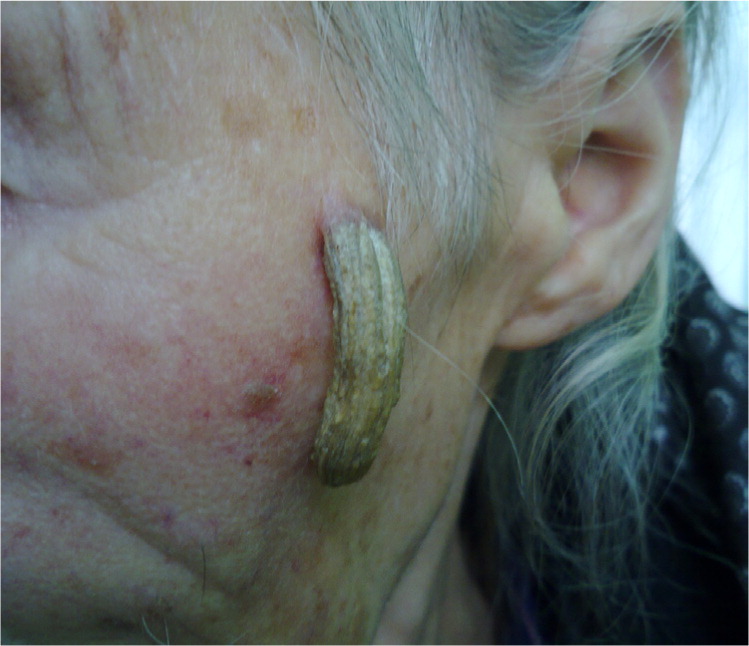
Large Growth on the Face
Am Fam Physician. 2012;86(3):273-274
Author disclosure: No relevant financial affiliations to disclose.
A 78-year-old woman presented with a large growth on her face that had been present for 11 years. The lesion was located in the zygomatic region, a sun-damaged area with aged skin.
Physical examination showed a hard, elongated, gray to yellowish hyperkeratotic mass (see accompanying figure). The lesion was 7.2 cm in length with a base diameter of 0.7 cm.

Question
Discussion
The answer is B: cutaneous horn. Cutaneous horn, or cornu cutaneum, refers to elongated, keratinous, gray to yellowish projections that range in size from a few millimeters to several centimeters.1 The reason for retention of keratin is unknown. This is a rare clinical diagnosis, and the incidence and prevalence in the general population are unknown.1 Cutaneous horns usually occur in light-skinned patients older than 50 years, and are more common in men.1 Approximately 30 percent of cutaneous horns occur on the upper face and scalp. Other common locations include sun-exposed areas such as the ear, lip, chest, neck, and shoulder.1,2
Cutaneous horns occur in association with a wide variety of underlying benign, premalignant, and malignant diseases, such as keratosis, sebaceous molluscum, verruca, trichilemmal cyst, Bowen disease, squamous cell carcinoma, malignant melanoma, and basal cell carcinoma.1–3 To make a histologic diagnosis, the lesion should be biopsied at the base of the horn.3 Cutaneous horns can be removed with simple excision using cauterization and cryosurgery.1,3
Actinic keratoses are hyperkeratotic lesions. They are usually multiple and comprised of either macules or papules with a rough, scaly surface resulting from disorganized keratinization and a variable degree of inflammation. Lesions vary from less than 1 mm to more than 2 cm, and are usually asymptomatic.3
Keratoacanthoma is composed of keratinizing squamous cells originating from pilosebaceous follicles. It is characterized by rapid growth to a relatively large size, and a regular crateriform shape with a keratotic plug and undamaged surrounding skin.3
Seborrheic keratoses are composed of epidermal keratinocytes, varying from a dirty yellow to black color with greasy keratin on the surface. The size can be from 1 mm to several centimeters.3 They have a classic “stuck on” appearance.

| Condition | Characteristics |
|---|---|
| Actinic keratosis | Hyperkeratotic lesions, usually multiple; comprised of either macules or papules with a rough, scaly surface resulting from disorganized keratinization and a variable degree of inflammation; usually asymptomatic; less than 1 mm to more than 2 cm in size |
| Cutaneous horn | Elongated, keratinous, gray to yellowish projections; a few millimeters to several centimeters in size |
| Keratoacanthoma | Usually grows rapidly to a relatively large size; regular crateriform shape and keratotic plug with undamaged surrounding skin |
| Seborrheic keratosis | Composed of epidermal keratinocytes, varying from dirty yellow to black in color with greasy keratin on the surface; 1 mm to several centimeters in size |

